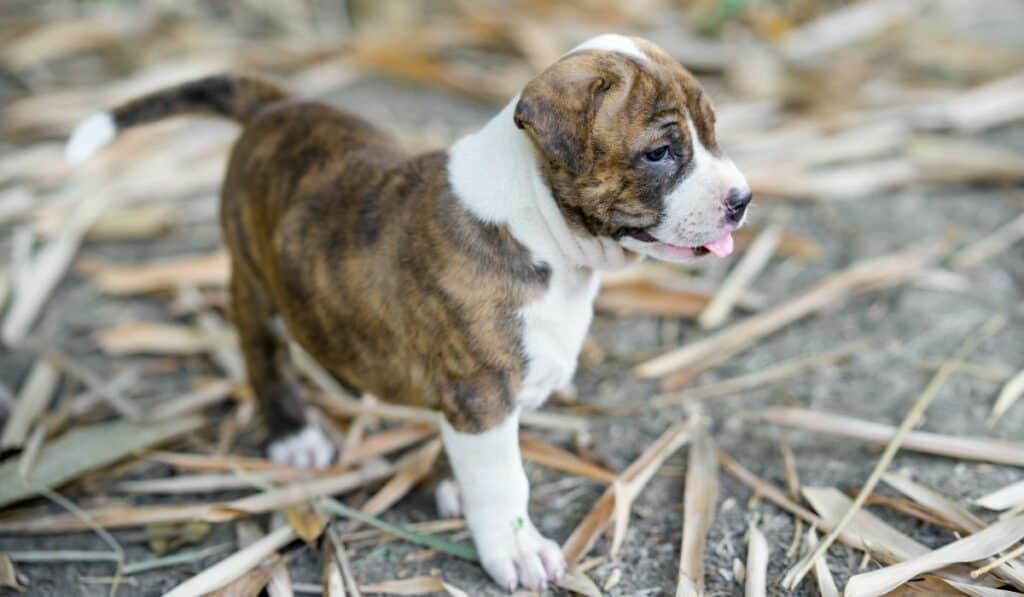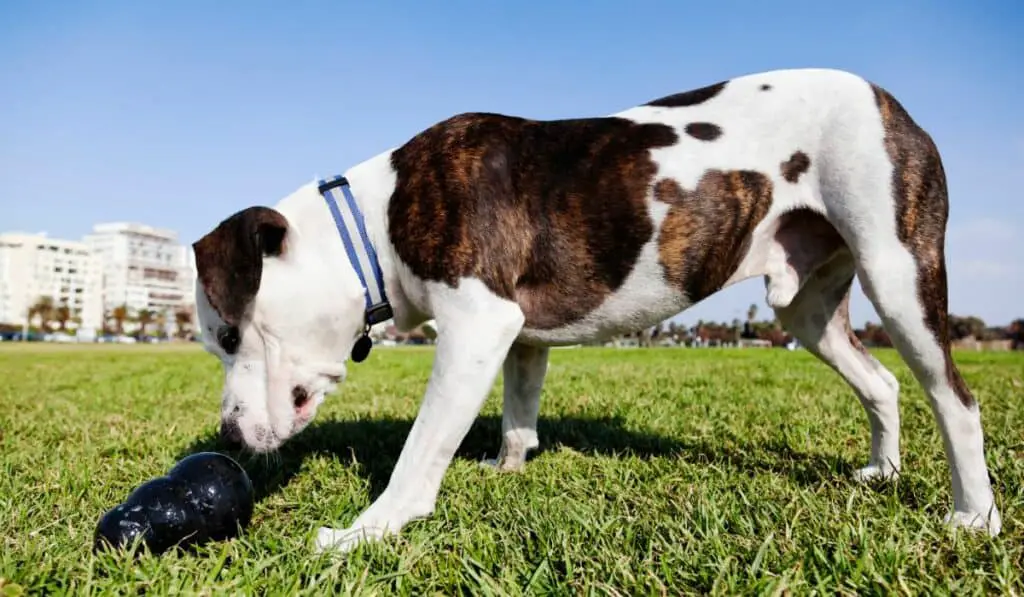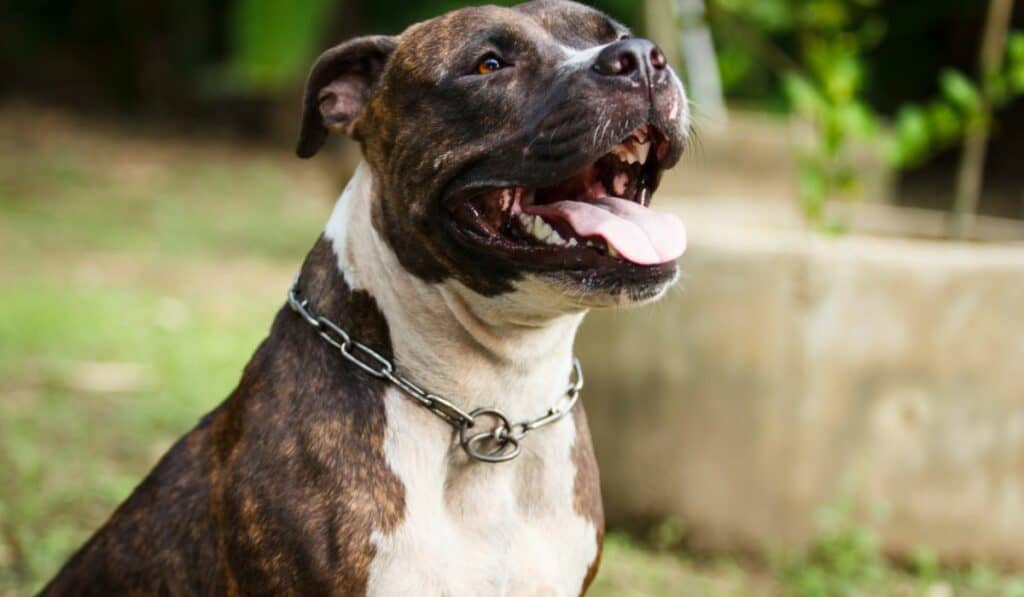Tri-color pitbull is a stunning and rare variation of the American Pitbull Terrier and American Bully breeds, known for their unique coat pattern featuring three colors.
Many dog enthusiasts find these fascinating canines highly appealing due to their eye-catching appearance. If you’re eager to learn more about these beautiful dogs, this article is for you!
What Is A Tri-Color Pitbull?
Tri-color pitbulls are a rare and unique variation of the American Pitbulls and bully breed dogs. Their distinct appearance sets them apart from other Pitbull types, as they have three colors in their coat instead of the usual two.
These beautiful dogs showcase combinations of black, white, tan, lilac, red, fawn, chocolate, or blue in an eye-catching patterned trio.

Just like any other Pitbull, these tri-colored furballs are purebred. The main difference between them and their brethren lies in the color of their coats. Known for their medium to large size, tri-color Pitbull are muscular and athletic in appearance, making them a perfect addition to an active lifestyle.
It is essential to understand that the term “tri-color Pitbull” can refer to any Pitbull dog. However, it is predominantly the American Pit Bull Terrier and the American Bully breeds that come in this unique tri-color coat.
Even though these dogs might seem more exotic or different due to their striking appearance, they share the same traits and temperament as their solid-colored counterparts.

Get the 7 Biggest Training Mistakes free report!
Tri-Color Pitbull Breeding And Genetics
When breeding tri-color pitbulls, it’s important to understand the genetics behind their unique coat colors. The tri-color pattern in Pitbulls is due to a recessive gene. Both parent dogs must carry this recessive gene for their puppies to have a tri-color coat.
There are multiple coat colors and patterns that can be seen in tri-color pitbulls. Some of the base coat colors include chocolate, lilac, and merle.
In addition, there’s the agouti pattern, where hairs have bands of different colors along their length. The dilution gene plays a role in creating lighter shades, such as purple tones in lilac and diluted chocolate coats.
While the tri-color variation is admired for its beauty, breeding tri-color pitbulls carries certain risks. Due to the nature of recessive genes, puppies with two sets of these genes are more prone to diseases and genetic disorders. Therefore, it’s crucial to be cautious while breeding these dogs to ensure the puppies’ health.

Avoid breeding two tri-color pitbulls together on your own, as the risk of genetic disorders increases. Steer clear of unethical breeders. Instead, only work with experienced breeders or professionals with expert genetics knowledge to minimize potential health risks.
Remember, tri-color pitbulls are still a relatively new variety, and more research is needed to understand their health predispositions better. By breeding responsibly and prioritizing the dogs’ well-being, you can contribute to a healthier future and the sustainability of this beautiful Pitbull variety.
Tri-Color Pitbull Appearance
Tri-color pitbulls have a unique coat featuring a combination of three colors black, blue, brown, red, fawn, white, and tan. These colors can appear in various patterns, including brindle, patched, and piebald. Some common variations you might see are back tri, blue tri, fawn tri, and champagne tri.
In terms of size and weight, tri-color pitbull will generally be similar to a standard Pitbull. You can expect the weight to range between 30 to 60 pounds. The height of these dogs can vary, but they are generally medium-sized dogs with a muscular build. Their appearance is defined by a large head and a lovable smile, as well as their distinctive coat colors.
The patterns on tri-color pitbull are a result of both selective and non-selective breeding techniques to bring out recessive genes in the dogs’ coats. For example, a tri-color pitbull with tan points will have white on the chest and paws, accompanied by tan spots and patches on its base coat color, creating a visually striking appearance.
Despite their stunning looks, it’s important to remember that tri-color pitbulls have the same lifespan and general health considerations as other pitbulls. While their coat patterns and colors are not directly linked to aggressive tendencies, some believe they might be less healthy than other fur types due to their recessive genetics.
However, being a responsible pitbull owner, providing your dog with regular exercise, a balanced diet, and proper veterinary care will ensure a happy and healthy life for your tri-color pitbull.
Tri-Color Pitbull Temperament And Personality
When it comes to the temperament and personality of a tri-color pitbull, you’ll be pleased to know they are loving, loyal, and make exceptional family pets. These dogs possess a pleasant disposition, and much like other Pitbull breeds, they are known for their strong bond with their human companions.

As a tri-color pitbull owner, you’ll find that they have a great deal of energy and enthusiasm. It is essential for you to provide regular exercise and playtime to keep your pitbull in shape, happy, and healthy. By establishing a consistent exercise routine, you can help reduce any potential for anxiety or restlessness in your pup.
Tri-color pitbulls are known for their trainability, which makes them an ideal companion for first-time dog owners. With proper training and socialization, you can expect your tri-color pitbull to be well-mannered and a joy to be around. Spend quality time with your dog to strengthen your bond and take full advantage of their loving and loyal nature.
In summary, the Tri Color Pitbull offers a perfect combination of temperament and personality traits, making them an excellent choice for a loyal and loving companion. Be sure to provide ample exercise, playtime, and training to keep your tri-color pitbull happy, and they will shower you with their unwavering affection.
Tri-Color Pitbull Health And Care
Being a tri-color pitbull owner, ensuring your furry friend stays healthy and well-groomed is essential. Knowing about common health issues and providing the proper care can help your dog lead a happy and comfortable life.
Common Health Issues
First, be aware of common health issues that tri-color pitbulls might face, such as hip dysplasia, cataracts, hypothyroidism, bloat (gastric dilation), congenital heart disease, and cancer. Regular vet check-ups can help detect these problems early and provide the necessary treatment.
To prevent or manage hip dysplasia, ensure your tri-color Pitbull maintains a healthy weight and gets regular exercise. Low-impact exercise such as swimming can be particularly beneficial. Feeding your dog a diet rich in omega-3 fatty acids may also help.
Regarding cataracts and hypothyroidism, keeping your tri-color pitbull’s diet balanced and supplying necessary nutrients can be beneficial. Consult your vet for any changes needed in your dog’s diet.
To avoid bloat or gastric dilation, which can be life-threatening, feed your pitbull smaller meals more frequently rather than one or two large ones. Ensure they don’t exercise intensely after eating and avoid foods that cause gas.
Diet And Grooming
Taking good care of a tri color Pitbull requires attention to its diet. High-quality dog food is essential, and the right balance of proteins, fats, carbohydrates, and essential nutrients should be maintained. Additionally, you may include supplements meant for maintaining the pitbull’s skin and coat health as part of the diet.
Consult your veterinarian for specific dietary recommendations based on your dog’s age, size, and activity level.

Grooming is also an essential aspect of your tri-color pitbull’s care. Although these dogs have short coats, regular brushing will help remove dead hair and keep their coats healthy.
Use a suitable brush for your pitbull, such as a rubber curry brush or soft bristle brush. Pay attention to other areas like cleaning your dog’s ears, trimming their nails, and brushing their teeth, as these can prevent future health issues.
By staying informed and providing proper health care and grooming, you’ll support your tri-color pitbull in living a happy, healthy life.
Final Thoughts
These pitbulls showcase a combination of black, white, tan, lilac, red, fawn, chocolate, or blue in their coats, resulting in a dynamic and captivating pattern.
The tri-color creates a distinctive look, attracting potential owners who want a unique canine companion. Understanding the genetics behind these tri-color coats can help clarify why they are rare and intriguing.
As you dive into the world of tri-color pitbulls, you’ll discover fascinating information about their patterns, shades, and the genetics behind their extraordinary appearance. Armed with this knowledge, you’ll be better equipped to appreciate and care for these wonderful dogs and witness firsthand how their beauty extends beyond their colorful coats.
Now that you know what a tri-color pitbull is, you can appreciate the rarity and beauty of these incredible dogs.
Just remember, regardless of coat color, all pitbulls are lovable and unique, with the potential to be loyal and affectionate members of your family.
